Contents
This is the personal website of Eric O'Dell, at least for certain values of personal. It's mostly technical information and software I've written that I wanted to share.
Technē
Articles
- Pseudo-Analog Palettes - A possible solution for the sometimes excessive regularity of digital painting, complete with some tools you can use yourself.
- Random Access Stable PRNGs - How to associate a stable random value with every point in a space of arbitrary dimensionality.
- The Apple II Palette - If you're old and nostalgic or young and into retrocomputing, the low- and high-resolution palettes of the Apple II are presented here as RGB triplets, ready to use for syntax highlighting or in CSS stylesheets.
Guides
- Internet Zero - A guide to running a telnet BBS in DOSBox.
- Troff and Unix Text Processing - A powerful typesetting language more than fifty years old, reconsidered.
NPM Modules
Here are some NPM modules that I maintain. The "Metrogon Informatics" branding in the graphics was an exercise in packaging Open Source software more like proprietary software.
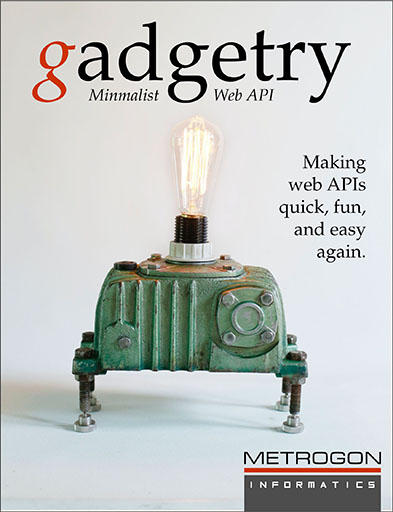 |
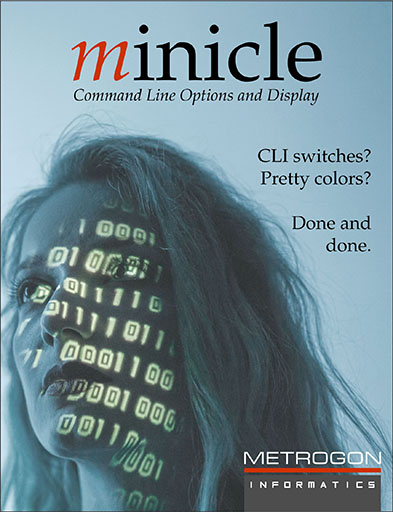 |
|
Building a web API with Node.js should be as simple as writing and calling functions locally, without the overhead of a kitchen sink framework. Gadgetry v1.0.0 does exactly that, using a unique JSON-over-POST remote procedure call model that is quick and easy without the overhead of a general-purpose application framework or mountains of XML. Read more about it here. |
If you're building a command line Node application and want to support complex CLI switches and Git-style commands, Minicle v2.1.3 can do it for you quickly and easily. And if you want to spice up your text output with ANSI colors, text formatting, and box drawing characters, we've got you covered. Click here to find out more. |
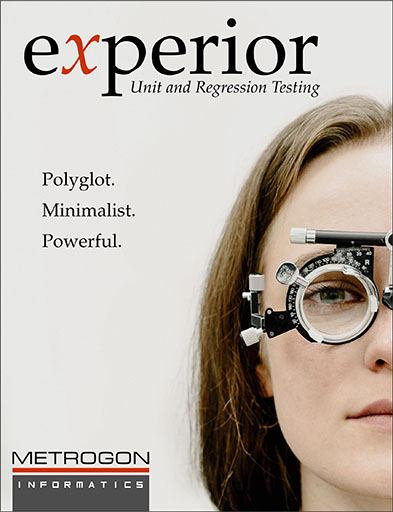 |
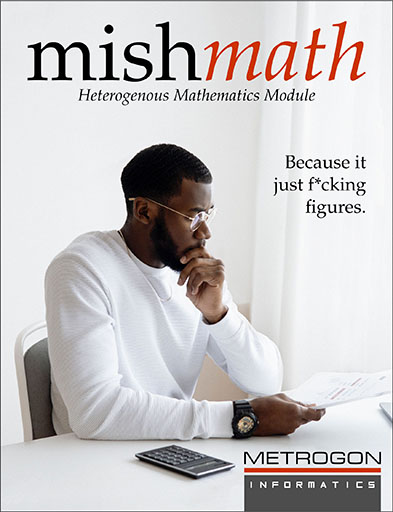 |
|
Unit and regression testing are simple in theory, and now Experior v1.0.1 makes them simple in practice. While written for Node.js, it is language-agnostic: as long as your program can include a short string of JSON along with its test output, Experior can process it. You can even write tests in JavaScript regardless of which language your application uses or use native tests and let Experior handle the results. Get the details here. |
Mishmath v0.0.9 is a curated collection of miscellaneous math and logic routines culled from other Open Source modules. With an emphasis on geometry and combinatorics, Mishmath is a good toolbox to keep handy for when you inevitably have to calculate the Chebyshev distances of a bunch of objects and then randomize them with a Fisher-Yates shuffle. Happens all the time. Click here to get the low-down. |
Toys
- Ultimate Tarot - This monster of
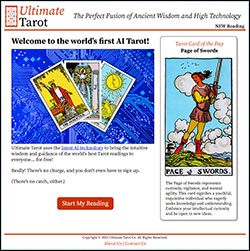 a subsite was an early effort to get GPT 3.5 to do Tarot interpretations, and
do them it did, some 40,000+ of them that live in individual JSON files, fetched
as needed and obviating the need for a database. The reading process is slickly animated
and uses the classic Pamela Coleman Smith card designs, which have the virtue of
being both attractive and public domain.
This used to live at its own domain where I hoped to make money from advertising,
but Google declined to index it, so it has come to live here as a portfolio piece.
a subsite was an early effort to get GPT 3.5 to do Tarot interpretations, and
do them it did, some 40,000+ of them that live in individual JSON files, fetched
as needed and obviating the need for a database. The reading process is slickly animated
and uses the classic Pamela Coleman Smith card designs, which have the virtue of
being both attractive and public domain.
This used to live at its own domain where I hoped to make money from advertising,
but Google declined to index it, so it has come to live here as a portfolio piece. - Diagrammata - Diagrammata assembles
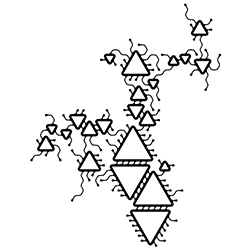 complex structures from simple rectilinear or hexagonal tiles by a random
process. Tiles are defined by their connectors on each side. The end result
of each run can be suprisingly complicated compared to the simplicity of the
tiles, and the same tileset can produce two or more radically different
patterns, analogous to crystal allotropes. More than 200 presets are
included if you just want to explore without getting into the process of
designing your own tiles. It is based on Paul Harrison's original Ghost Diagrams and
licensed under the GPL.
complex structures from simple rectilinear or hexagonal tiles by a random
process. Tiles are defined by their connectors on each side. The end result
of each run can be suprisingly complicated compared to the simplicity of the
tiles, and the same tileset can produce two or more radically different
patterns, analogous to crystal allotropes. More than 200 presets are
included if you just want to explore without getting into the process of
designing your own tiles. It is based on Paul Harrison's original Ghost Diagrams and
licensed under the GPL. - Martin Attractor Fractal - The
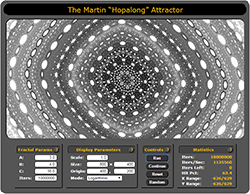 Martin Attractor is an orbit fractal that was first discovered by Barry
Martin at Aston University, Birmingham, UK, and later popularized under the
name Hopalong by A.K. Dewdney in the pages of Scientific American in 1986.
(Dewdney chose the name because of the somewhat quirky order in which the
points are plotted, i.e., they "hop along" elliptical paths from the
center.) Martin preferred the name "Martin Attractor" for them, but the
Hopalong name stuck.
Martin Attractor is an orbit fractal that was first discovered by Barry
Martin at Aston University, Birmingham, UK, and later popularized under the
name Hopalong by A.K. Dewdney in the pages of Scientific American in 1986.
(Dewdney chose the name because of the somewhat quirky order in which the
points are plotted, i.e., they "hop along" elliptical paths from the
center.) Martin preferred the name "Martin Attractor" for them, but the
Hopalong name stuck. - Ulam Spiral Explorer - The Ulam Spiral was
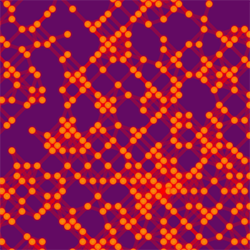 discovered by mathematician Stanislaw Ulam in 1963 while idly doodling
during a what he described as a boring presentation. It consists of a
rectilinear spiral of integers with the prime numbers marked by dots. To
Ulam's surprise, this revealed unexpected structures in the supposedly
random distribution of prime numbers on the integer number line. This tool
lets you explore variations on the Ulam Spiral, including some silly
features for transforming the spiral into abstract art at least as good as
what you'll see in your doctor's waiting room. You can read more about it here or jump straight to the toy here.
discovered by mathematician Stanislaw Ulam in 1963 while idly doodling
during a what he described as a boring presentation. It consists of a
rectilinear spiral of integers with the prime numbers marked by dots. To
Ulam's surprise, this revealed unexpected structures in the supposedly
random distribution of prime numbers on the integer number line. This tool
lets you explore variations on the Ulam Spiral, including some silly
features for transforming the spiral into abstract art at least as good as
what you'll see in your doctor's waiting room. You can read more about it here or jump straight to the toy here. - Minimal Oracle - This started as a Perl script (and snark) when I was working for a company that did online Tarot readings. It consists of several oracles of varying degrees of seriousness, from the obligatory coin flip and Magic 8-Ball, to Art Wells' lyrical I-Ching adaptation, Newwings, (and a couple of Tarot-like remixes of it), four variations on Brian Eno's Oblique Strategies deck, and the Viking Runes. It's a pretty straight port of the original commandline Perl program and it shows.
- Miscellaneous Toys - This is a collection of minor experiments that are currently (and perhaps permanently) too small to warrant their own pages. Right now, it contains a harmonic progression calculator and an algorithmic art generator.